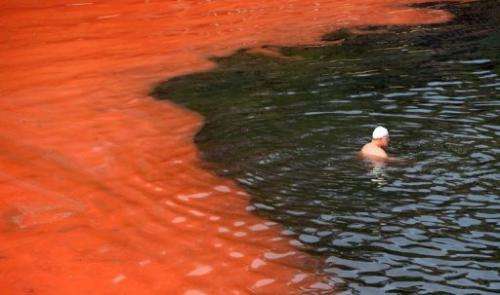A swimmer stops short of a red algae bloom at Sydney's Clovelly Beach on November 27, 2012, which closed some beaches for swimming including Bondi Beach for a period of time.
A huge red algal bloom along vast stretches of southeastern Australia's coastline Thursday resulted in beaches being closed and turned swathes of usually pristine ocean milky pink.
The algae, noctiluca scintillans, forced the closure of Sydney's Bondi beach and a number of neighbouring inlets earlier this week, and government officials said it had now spread along the fringes of two states.
"Samples taken at Bondi Beach on 27 November confirmed the presence of noctiluca scintillans, which appears as a pinkish to reddish discolouration in water," the New South Wales government's water office said.
"It can also appear to be phosphorescent at night."
Aerial footage shot over neighbouring Victoria state showed huge blooms of the oily pink scum off Bells Beach, a popular surfing spot, and Lorne, south of Melbourne.
Some keen surfers were seen paddling undeterred through the muck, which has a fishy odour and can irritate the skin and eyes but is not dangerous to humans.
Fisherman were advised not to eat anything caught in an affected area as a precaution.
"There are no practical options for treating marine algal blooms," said Peter Codd from Victoria's department of sustainability and environment.
"The best option is to let the bloom run its course and be broken up and dispersed by rough weather."
Commonly known as "sea sparkle" due to its bluish glow at night, noctiluca scintillans blooms typically occur as a result of currents bringing cold, nutrient-rich water to the surface.
It is also known as the "sea ghost" or "fire of the sea".
(c) 2012 AFP























